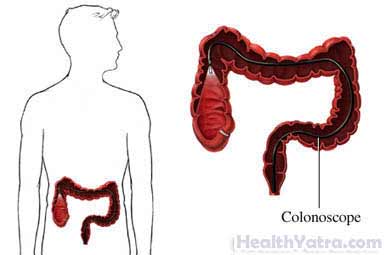Definition
A colonoscopy is an exam of the large intestine, also known as the colon. The exam is done with a tool called a colonoscope. The colonoscope is a flexible tube with a tiny camera on the end. This tool allows the doctor to view the inside of your colon.

Reasons for Procedure
A colonoscopy is used to examine, diagnose, and treat problems in your colon. The procedure is most often done to:
- Determine the cause of abdominal pain, rectal bleeding, or a change in bowel habits
- Detect and treat colon cancer or colon polyps
- Take tissue samples for testing
- Stop intestinal bleeding
- Monitor response to treatment if you have inflammatory bowel disease
Possible Complications
Complications are rare, but no procedure is completely free of risk. If you are planning to have a colonoscopy, your doctor will review a list of possible complications, which may include:
- Bleeding
- Puncture of the bowel
Factors that may increase the risk of complications include:
- Smoking
- Pre-existing heart or kidney condition
- Treatment with certain medicines, including aspirin and other drugs with blood-thinning properties
- Prior abdominal surgery or radiation treatments
- Active colitis, diverticulitis, or other acute bowel disease
- Previous treatment with radiation therapy
Be sure to discuss these risks with your doctor before the procedure.
What to Expect
Prior to Procedure
Your doctor will likely do the following:
- Perform a physical exam
- Review your health history
- Review any medication you are taking
- Test your stool for blood
Talk to your doctor about your medicines. You may be asked to stop taking some medicines up to one week before the procedure, like:
- Anti-inflammatory drugs
- Blood thinners like clopidogrel or warfarin
- Iron supplements or vitamins containing iron
On the day of the procedure:
- Wear comfortable clothing.
- Arrange for a ride home after the procedure.
Emptying the Colon
Your colon must be completely clean before the procedure. Any stool left in the colon will block the view. This preparation may start several days before the procedure. Follow your doctor’s instructions, which may include any of the following cleansing methods:
- Enemas—fluid introduced into the rectum to stimulate a bowel movement
- Laxatives—medicines that cause you to have soft bowel movements
- Oral cathartic medicines—a large container of fluid to drink that stimulates a bowel movement
For the entire day before your procedure:
- Do not eat any solid foods. This includes milk or cream in your coffee.
- Drink only clear liquids such as water, coffee without cream, ginger ale, apple juice, Gatorade (do not drink red Gatorade)
- You can also have Jello or popsicles as long as they are not red
- Do not drink alcohol
- If you have diabetes, ask your doctor if you need to adjust your insulin dose
Anesthesia
Your doctor may give you medication to help you relax.
Description of the Procedure
You will lie on your left side. Your knees will be drawn up toward your chest. The colonoscope will be slowly inserted through the rectum. The colonoscope will inject air into the colon. The doctor will be able to see the lining of the colon with a small video camera on the colonoscope. The colonoscope will be gently passed through the colon to view the entire area.
A tissue sample or polyps may be removed during the procedure. This is done with small tools passed through the colonoscope.
How Long Will It Take?
Less than one hour
Will It Hurt?
Most people report some discomfort when the instrument is inserted. You may feel cramping, muscle spasms, or lower abdominal pain during the procedure. You may also feel the urge to move your bowels. Tell the doctor if you feel any severe pain.
After the procedure, gas pains and cramping are common. These pains should go away with the passing of gas.
Post-procedure Care
If any tissue was removed:
- It will be sent to a lab to be examined. It may take 1-2 weeks for results. The doctor can usually give an initial report after the scope is removed. Other tests may be advised.
- A small amount of bleeding may occur during the first few days after the procedure.
Be sure to follow your doctor’s instructions when you return home. Some general recommendations include:
- Resume medicines as advised by your doctor.
- Resume normal diet, unless directed otherwise by your doctor.
- The sedative will make you drowsy. Avoid driving, operating machinery, or making important decisions for the rest of the day.
- Rest for the remainder of the day.
Call Your Doctor
After arriving home, contact your doctor if any of the following occur:
- Bleeding from your rectum—Notify your doctor if you pass a teaspoonful of blood or more.
- Black, tarry stools
- Severe abdominal pain
- Hard, swollen abdomen
- Signs of infection, including fever or chills
- Inability to pass gas or stool
- Coughing, shortness of breath, chest pain, severe nausea or vomiting
In case of an emergency, call for medical help right away.
